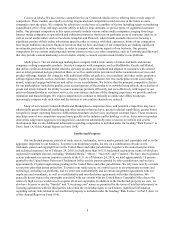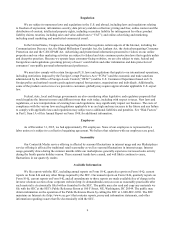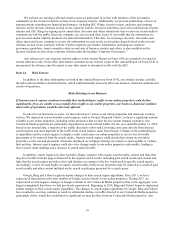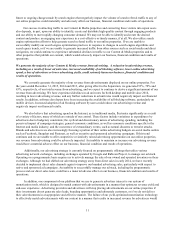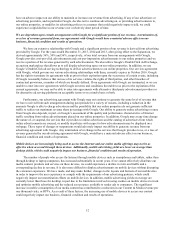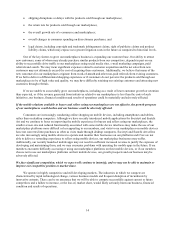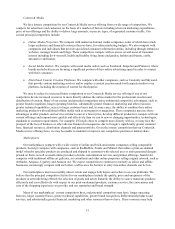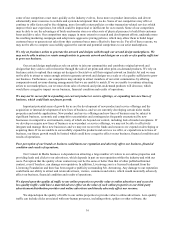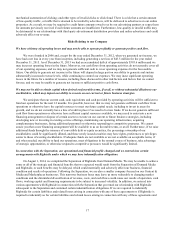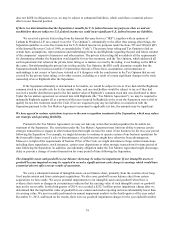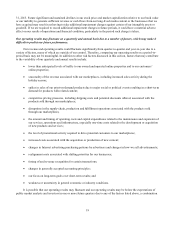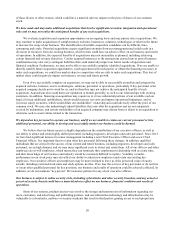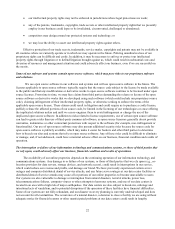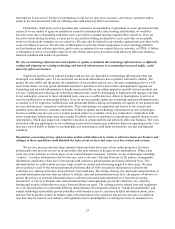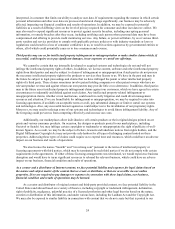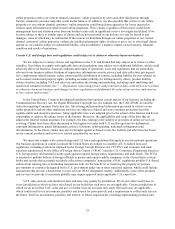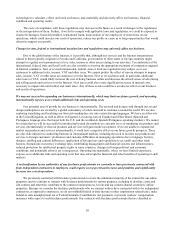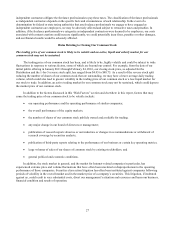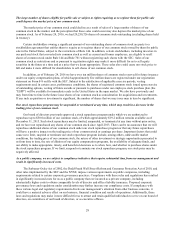Enom 2015 Annual Report Download - page 20
Download and view the complete annual report
Please find page 20 of the 2015 Enom annual report below. You can navigate through the pages in the report by either clicking on the pages listed below, or by using the keyword search tool below to find specific information within the annual report.18
does not fulfill its obligations to us, we may be subject to substantial liabilities, which could have a material adverse
effect on our financial position.
If there is a determination that the Separation is taxable for U.S. federal income tax purposes, then we and our
stockholders that are subject to U.S. federal income tax could incur significant U.S. federal income tax liabilities.
We received a private letter ruling from the Internal Revenue Service (“IRS”), together with an opinion of
Latham & Watkins LLP, tax counsel to us (the “Tax Opinion”), substantially to the effect that, among other things, the
Separation qualifies as a tax-free transaction for U.S. federal income tax purposes under Sections 355 and 368(a)(1)(D)
of the Internal Revenue Code of 1986, as amended (the “Code”). The private letter ruling and Tax Opinion relied on
certain facts, assumptions, representations and undertakings from us and Rightside regarding the past and future conduct
of the companies’ respective businesses and other matters. The private letter ruling did not address all the requirements
for determining whether the Separation would qualify for tax-free treatment, and the Tax Opinion, which addressed all
such requirements but relied on the private letter ruling as to matters covered by the ruling, is not binding on the IRS or
the courts. Notwithstanding the private letter ruling and the Tax Opinion, the IRS could determine on audit that the
Separation should be treated as taxable if it determines that any of these facts, assumptions, representations or
undertakings is not correct or have been violated or if it disagrees with the conclusions in the Tax Opinion that are not
covered by the private letter ruling, or for other reasons, including as a result of certain significant changes in the stock
ownership of us or Rightside after the Separation.
If the Separation ultimately is determined to be taxable, we would be subject to tax as if we had sold the Rightside
common stock in a taxable sale for its fair market value, and our stockholders would be subject to tax as if they had
received a taxable distribution equal to the fair market value of Rightside’s common stock that was distributed to them.
Under the tax matters agreement we entered into with Rightside (the “Tax Matters Agreement”), we may be required to
indemnify Rightside against all or a portion of the taxes incurred by Rightside in the event the Separation were to fail to
qualify for tax-free treatment under the Code. If we are required to pay any tax liabilities in connection with the
Separation pursuant to the Tax Matters Agreement or pursuant to applicable tax law, the amounts may be significant.
We have agreed to various restrictions to preserve the non-recognition treatment of the Separation, which may reduce
our strategic and operating flexibility.
Pursuant to the Tax Matters Agreement, we may not take any action that would jeopardize the favorable tax
treatment of the Separation. The restrictions under the Tax Matters Agreement may limit our ability to pursue certain
strategic transactions or engage in other transactions that might increase the value of our business for the two-year period
following the Separation. For example, we might determine to continue to operate certain of our business operations for
the foreseeable future even if a sale or discontinuance of such business might have otherwise been advantageous.
Moreover, in light of the requirements of Section 355(e) of the Code, we might determine to forgo certain transactions,
including share repurchases, stock issuances, certain asset dispositions or other strategic transactions for some period of
time following the Separation. In addition, our indemnity obligation under the Tax Matters Agreement might discourage,
delay or prevent a change of control transaction for some period of time following the Separation.
The intangible assets and goodwill on our balance sheet may be subject to impairment. If our intangible assets or
goodwill become impaired we may be required to record a significant non-cash charge to earnings which would have
a material adverse effect on our results of operations.
We carry a substantial amount of intangible assets on our balance sheet, primarily from the creation of our long-
lived media content and from certain past acquisitions. We also carry goodwill on our balance sheet from certain
acquisitions we have made. We assess potential impairments to our intangible assets and goodwill when there is
evidence that events or changes in circumstances indicate that the carrying value of such intangible assets or goodwill
may not be recoverable. In the third quarter of 2014, we recorded a $232.3 million pretax impairment charge after we
determined that the implied fair value of goodwill in our content and media reporting unit was substantially lower than
its carrying value. We most recently performed our annual impairment analysis in the fourth quarter of the year ended
December 31, 2015, and based on the results, there were no goodwill impairment charges for the year ended December


